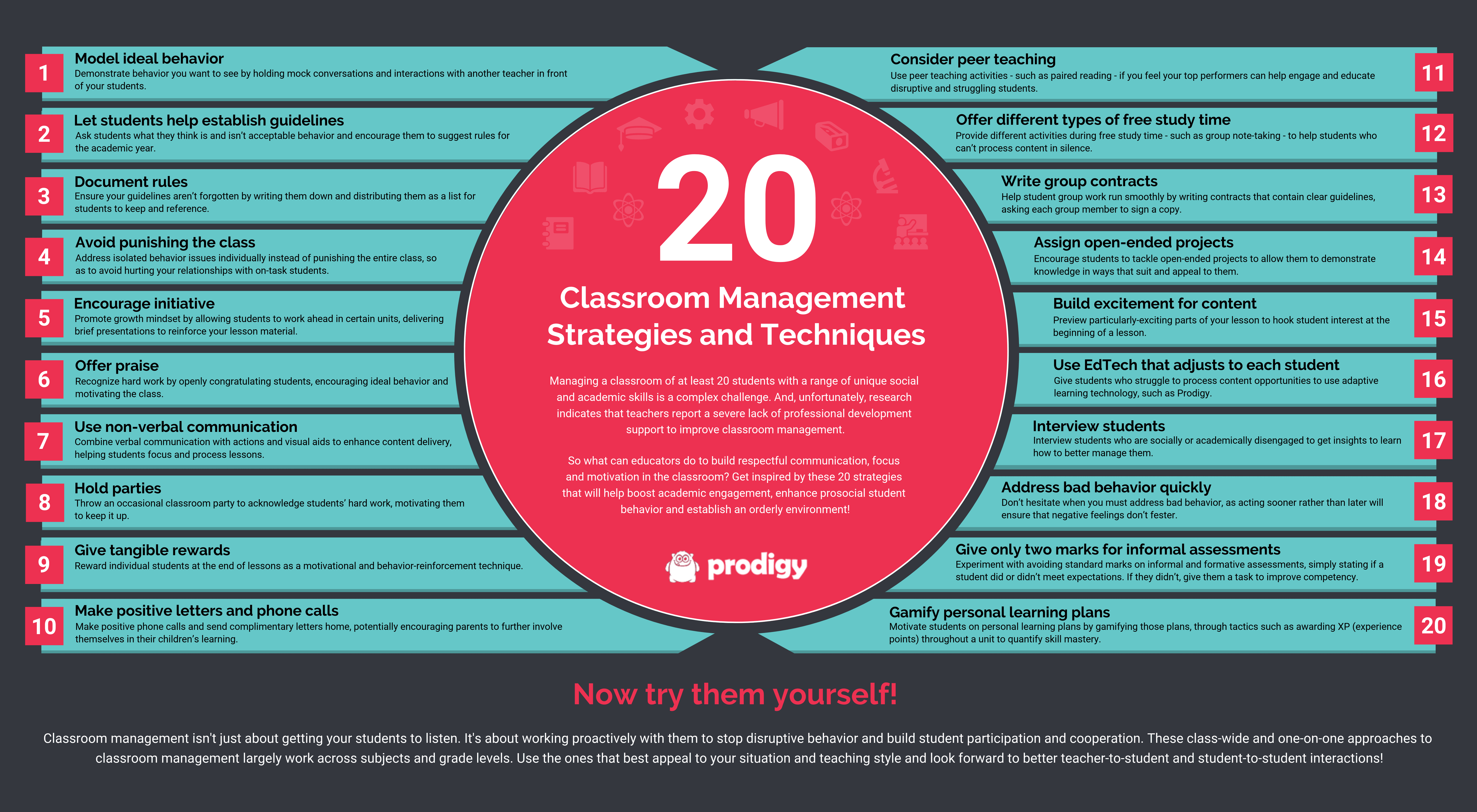How To Maintain A Positive Learning Environment In The Classroom
Newspaper airplanes fly across the room. Students race between desks. You tin can't get a word in, equally they yell over you lot.
Confusing beliefs doesn't have to exist this dramatic, like a movie scene you'd lookout man in a media literacy lesson, just poor classroom management volition near convincingly elevate your stress and burnout rates.
Unfortunately, a 2019 report indicates that teachers overwhelmingly report a lack of professional development support in improving classroom management. Despite this unideal state of affairs, in that location are straightforward and constructive classroom management approaches you tin can implement by yourself. These approaches can enhance prosocial educatee beliefs and bookish appointment, establishing an orderly learning environment.
Bachelor as a downloadable list to keep at your desk, below are xx research-backed classroom management strategies and techniques.
Utilise the ones that best entreatment to your situation and educational activity style.
Universal classroom management strategies for educators
These 20 classroom direction techniques have shown to improve classroom beliefs, build relationships for a better classroom community, and foster a positive classroom environment where pupil learning is the number one collective goal.
Try these effective classroom direction strategies with your students to become a happier, more effective teacher.
1. Model platonic behavior
Make a habit of demonstrating behavior you desire to meet, as many studies bear witness that modelling finer teaches students how to human activity in different situations.
A straightforward way to model certain behaviors is holding a mock conversation with an administrator, other teacher or pupil helper in forepart of the class. Talking about a test or other relatable topic, exist certain to:
- Use polite linguistic communication
- Maintain eye contact
- Proceed phones in your pockets
- Let 1 another speak uninterrupted
- Raise concerns about one another'southward statements in a respectful manner
After, beginning a class discussion to listing and expand upon the ideal behaviors you exemplified.
2. Permit students help institute guidelines

Encourage all students to assist you lot build classroom expectations and rules, as you'll generate more than buy-in than only telling them what they're not immune to do.
This is especially essential for new teachers. Near the get-go of the school year or during the outset mean solar day of a semester, start a discussion by asking students what they believe should and shouldn't wing in terms of advisable behavior.
At what points are phones okay and not okay? What are adequate racket levels during lessons?
This may seem like you're setting yourself up for failure, but -- depending on the makeup of your class -- you may exist shocked at the strictness of some proposed rules. Regardless, having a word should lead to mutually-understood and -respected expectations for your classroom culture.
three. Document rules
Don't let your mutually-respected guidelines go forgotten.
Similar to handing out a syllabus, print and distribute the list of rules that the class give-and-take generated. And then, get through the list with your students. Doing this emphasizes the fact that you respect their ideas and intend to adhere to them. And when a student breaks a rule, information technology'll be easy for yous to point to this document.
You'll likely want to mail these rules up in your classroom — if you lot haven't already — for occasional reference. If you're feeling creative, you tin include the rule list in a student handbook with important dates, events and curriculum information, too.
4. Avert punishing the form
Address isolated field of study problems individually instead of punishing an entire form, every bit the latter can injure your relationships with students who are on-task and thereby jeopardize other classroom management efforts.
Instead, call out specific students in a friendly manner. For example:
- "Do y'all have a question?", not "Finish talking and disrupting other students"
- "Do you lot need assist focusing?", non "Pay attention and stop fooling around while I'm talking"
This bones approach will permit you to keep a friendly disposition, while immediately acknowledging inappropriate behavior.
v. Encourage initiative

Promote growth mindset, and inject multifariousness into your lessons, pastallowing students to work ahead and evangelize short presentations to share have-away points. Almost inevitably, you'll have some eager learners in your classroom. Yous can merely enquire them if they'd similar to get ahead from time-to-time.
For example, if you lot're reading a specific affiliate in a textbook, propose that they read the following one too. When they deliver their subsequent presentations to preview the next chapter on your behalf, you may notice that other students want a bit more work likewise.
vi. Offer praise
Praise students for jobs well done, as doing so improves bookish and behavioral performance, according to a recent research review and study.
When it is sincere and references specific examples of effort or accomplishment, praise can:
- Inspire the class
- Improve a student's self-esteem
- Reinforce rules and values you want to see
Perhaps more importantly, information technology encourages students to repeat positive behavior. Let'south say a pupil exemplifies advanced problem-solving skills when tackling a math give-and-take problem. Praising his or her use of specific tactics should go a long way in ensuring he or she continues to utilise these tactics. Non to mention, you'll motivate other students to practise the same.
7. Use non-verbal advice

Complement words with actions and visual aids to improve content commitment, helping students focus and procedure lessons.
Many differentiated pedagogy strategies and techniques are rooted in these communication methods. For example, running learning stations -- divided sections of your classroom through which students rotate -- allows you lot to deliver a range of non-spoken content types. These include videos, infographics and physical objects such as counting coins.
viii. Agree parties
Throw an occasional classroom party to admit students' hard work, motivating them to go on it up.
Even if it's just for 20 or 30 minutes, they should be happy with snacks and a selection of group games to play. Clarify that you lot're property the political party to reward them and they can earn future parties by demonstrating ideal behavior, collectively scoring high on assessments and more.
ix. Give tangible rewards

Advantage specific students at the terminate of each lesson, in front of the class, equally another motivational and behavior-reinforcement technique.
Allow's say a few students are actively listening throughout the entire lesson, answering questions and asking their own. Before the class ends, walk over to their desks to give them raffle tickets. So others can larn, state aloud what each student did to earn the tickets. On Friday, they tin submit their tickets for a shot at a prize that changes each week -- from candy to being able to choose a game for the next form political party.
10. Brand positive letters and phone calls
Keep students happy in and out of class past pleasantly surprising their parents, making positive phone calls and sending free messages home.
When the occasion arises, from academic attempt or behavioral progress, letting parents know has a trickle-downwards outcome. They'll generally congratulate their kids; their kids will probable come to class eager to earn more positive feedback. This can also entice parents to grow more invested in a child's learning, opening the door to at-abode lessons. Such lessons are a mainstay element of culturally-responsive teaching.
11. Build excitement for content and lesson plans

This one works well no matter the grade level: elementary school, middle school or loftier school. Start lessons by previewing particularly-exciting parts, hooking student interest from the outset.
As the bell rings and students settle, go through an calendar of the twenty-four hours'southward highlights for the whole course. These could include group tasks, engaging $.25 of content and anything else to pique marvel. For example, "Throughout the mean solar day, you'll learn about:"
- How to talk like y'all're a teacher (sentence structure)
- Why you don't know anyone who's won the lottery (probability)
- What all the presidents of the United states have had in mutual (social analysis)
The goal of this classroom direction technique is to immediately interest students in your calendar and thereby dissuade misbehavior.
12. Offer unlike types of costless study fourth dimension
Provide a range of activities during free study time to appeal to students who struggle to process content in silence, individually.
You can do this by dividing your class into clearly-sectioned solo and team activities. In split up sections, consider:
- Providing audiobooks, which can play cloth relevant to your lessons
- Maintaining a designated serenity space for students to take notes and complete work
- Creating a station for challenging group games that teach or reinforce standards-aligned skills
- Allowing students to work in groups while taking notes and completing work, away from placidity zones
By running these sorts of activities, free study time will brainstorm to benefit diverse learners. This should contribute to overall classroom engagement.
13. Write group contracts

Assist student group work run smoothly and effectively past writing contracts that contain guidelines, having everyone sign.
Group contracts should exist based on expectations that students have for each other, and you have for them. You tin gather the class's thoughts past holding a discussion about what the ideal group fellow member does, and how he or she acts. Once you've written the contract, encourage students to come up with consequences for violating expectations.
Past having them sign a fresh version of the contract earlier each group task and projection, y'all're empowering them to concur each other accountable.
14. Assign open-ended projects
Encourage students to tackle open-ended projects -- projects that don't demand a specific product -- to let them to demonstrate knowledge in ways that inherently accommodate them.
This starts past giving the class a list of broad project ideas, asking each educatee to cull one. Be sure to provide a rubric for each project that clearly defines expectations. By both enticing and challenging students, you should find they'll:
- Piece of work and larn at their own paces
- Engage actively with appropriate content
- Demonstrate noesis equally finer every bit possible
With these benefits, students may actually wait forward to taking on new projects.
xv. Requite only ii scores for informal assessments

Recall a time you saw a big "F" in red ink on your work. Y'all were probably also upset to review mistakes and feedback, so are your students when they see the same.
So, consider avoiding standard marks on informal and formative assessments.
Instead, just land if a student did or did not meet expectations. Then, provide struggling students with a articulate path to improve. For instance, pair classmates who didn't meet expectations with those who did, giving them a review and practice activity. When strugglers are confident they sympathise key concepts, encourage them to tell you. Provide a new assessment, allowing them to prove their competency.
Classroom management strategies for individual students
sixteen. Use EdTech that adjusts to each educatee
Requite students who struggle to process your content opportunities to attempt educational technology that adapts to their needs.
There are many games and platforms that use adaptive learning principles to find a given student's skill deficits, serving them content to assistance overcome them.
For example, Prodigy Math adjusts its content to help students in grades 1 to 8 address their trouble spots. It also offers feedback to help them solve specific mistakes, equally they answer questions that employ words, charts, pictures and numbers.
Sign upwardly for your costless teacher business relationship today!
17. Interview students
Interview students who aren't academically engaged or displaying prosocial behavior to larn how to better manage them.
While running learning stations or a large-group activity, pull each student aside for a few minutes. Enquire about:
- What helps them focus
- Who they work well with
- Their favorite types of lessons
- Their favorite in-grade activities
- Which kinds of exercises aid them retrieve key lesson points
Annotation their answers to come up with activities and approaches that engage them, thereby limiting classroom disruptions.
18. Address inappropriate or off-task behavior quickly

Avoid hesitation when you must address inappropriate or off-task behavior, peculiarly when a student breaks a documented dominion.
Interim sooner than later on will help ensure that negative feelings -- whether between students or you and a educatee -- won't fester. Failure to deed tin event in more poor behavior, leading to needlessly-hard conversations.
But keep in heed: Information technology'south usually all-time to talk to the student in individual. Research shows that punishing students in front of peers has "express value."
19. Consider peer education
Use peer teaching as a classroom management strategy if you feel your top performers can help engage and brainwash disruptive and struggling students.
Peer teaching activities, such as pairing students together as reading buddies, can existparticularly benign for students who suffer from low confidence and poor interpersonal skills.
Authoritative research states tutors improve cocky-esteem and interpersonal skills by giving feedback. Tutees realize benefits because they tin can ask questions and receive firsthand clarification. A afterwards study of at-risk students echoes these advantages. Although you should spend fourth dimension teaching peer tutors how to properly communicate with tutees, you'll likely find the benefits are worth the work.
xx. Gamify personal learning plans

Motivate students on personal learning plans by gamifying those plans, as studies — such as recent research from Republic of korea — betoken this will continuously engage and incentivize them.
Consider gamification strategies such every bit:
- Adjusting your scoring arrangement --Give experience points (XP) -- along with traditional scores -- on tests and assignments, setting a goal for the student to accomplish a sure amount of XP per unit. For example, if a pupil scores lx% on a quiz, give him or her 6,000 XP. You can likewise award XP for completing actress assignments, participating in form or anything else that shows effort to acquire.
- Using stages --Refer to topics and units every bit stages. The former terms have clear connotations for you, simply students may not run into how they fit together. If they're gamers, they'll understand that reaching the next stage requires overcoming precursory challenges. Emphasize this by framing certain tasks as prerequisites to achieve the side by side learning phase.
If these strategies work especially well for individual students, you should see similar success past using them as class-broad pupil direction techniques.
Downloadable list of classroom direction strategies for teachers
Click here to download a simplified list of the above classroom management strategies and techniques to print and proceed at your desk-bound.
Classroom direction strategies infographic
Below is an infographic based on this commodity, helping you deploy these classroom management strategies at your own school!

Click to expand! Created by Venngage Infographics that recently launched its ain banner maker.
Classroom management FAQs
What is the best classroom management style?
According to Diana Baumrind'south piece of work, a clinical psychologist known for her research on parenting styles, some educators believe an authoritative classroom management fashion may the best one. This type of high command, loftier interest classroom direction style is characterized by stiff expectations of appropriate behavior, articulate understandings of why sure behaviors are adequate and others non acceptable, and warm pupil-teacher relationships.
However, there is no specific approach that has been proven to be the most effective. So you may wish to review The Classroom Management Book by Harry M. Wong and Rosemary T. Wong which includes a variety of solutions that tin be easily implemented. Every group of students has varying needs and will likely need a unique approach to help every student bring his or her best cocky to the classroom and be ready-to-learn every single day.
What are the four components of classroom management?
Implementing the summit four components of classroom management from the start will set you lot and your students upwards for success all year long. They are:
- Classroom design — be intentional about how you set up your desk-bound, your students' desks, bulletin lath displays, devices and other aspects of your classroom. Thoughtful classroom blueprint can help create a safe and welcoming learning environment.
- Rules/discipline — to create a safety and caring school community, develop classroom rules your students understand and — hopefully — respect. While information technology may not be fun, be sure to communicate that breaking classroom rules will accept concrete yet fair consequences.
- Scheduling/organization — being on time, keeping on task and staying organized will assistance set your lessons (and your students' learning) up for success.
- Instructional technique — while y'all may not have the flexibility yous'd similar when information technology comes to content and curriculum, you should have the liberty to choosehow yous teach. For example, 8th form students may prefer a lecture-style lesson with small grouping discussions while 3rd grade students may prefer learning math with a digital game-based learning platform. Find how your students larn best and use the classroom management strategies and techniques to teach your lessons.
Why is classroom management so important?
When washed effectively, classroom management is of import for three chief reasons. It:
- Creates and sustains an orderly learning surroundings in the classroom
- Improves meaningful academic learning and fosters social-emotional growth
- Increases students' academic engagement and lowers negative classroom behavior
Concluding thoughts about these classroom management strategies
These class-wide and 1-on-one approaches to classroom management largely work beyond subjects and grade levels. Implementable without admin and parent support, they should empower you to plant an orderly — yet friendly and engaging — surroundings.
Look forwards to ameliorate teacher-to-educatee and student-to-pupil interactions every bit a result.
Looking for a fun way to engage and reward your students? Endeavour Prodigy Math! Aligned with curricula for grades 1 to viii, students volition do key skills while too exploring an exciting fantasy globe.
Plus, y'all'll get access to costless teacher tools that help you lot differentiate math content, transport assessments and collect pupil insights — in just a few clicks.
Source: https://www.prodigygame.com/main-en/blog/classroom-management-strategies/
Posted by: brownpiten2002.blogspot.com


0 Response to "How To Maintain A Positive Learning Environment In The Classroom"
Post a Comment